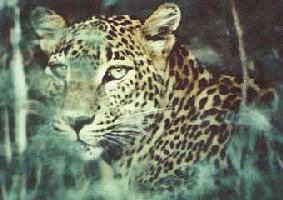

![]()
Certain animals of one and the same kind (species) coming from different geographic areas differ in certain features from those coming from other areas. To recognize and identify these characteristic forms and features from different geographical and environmental areas, taxonomists described them as ‘subspecies’.
 To
quote Seidensticker, “Members of a subspecies share a unique geographical
range or habitat, have identifiable physical characteristics, and have a unique
natural history relative to other subspecies in the species. Subspecies may
arise over time; for instance, the fossil lions of America are considered one
species of lion, and the modern lion another. Subspecies may also arise through
what scientists call ‘geographic partitioning’.
To
quote Seidensticker, “Members of a subspecies share a unique geographical
range or habitat, have identifiable physical characteristics, and have a unique
natural history relative to other subspecies in the species. Subspecies may
arise over time; for instance, the fossil lions of America are considered one
species of lion, and the modern lion another. Subspecies may also arise through
what scientists call ‘geographic partitioning’.
This simply means that population of animals living in different areas, usually separated by barriers such as mountain ranges or seas, evolve some different traits, but not ones that would prevent individuals from breeding successfully with one another should they come together. In fact, sometimes subspecies ‘collapse’ when the barrier that separated them is removed. In contrast, species, such as lions and tigers, retain their identity even when they occur in the same areas in the wild. Scientists add a third word to the scientific name to indicate a subspecies. For example, fossil lions are called Panthera leo atrox and the modern African lions Panthera leo.”
Very recently Stephen J. O’Brien ( a principal contributor to the Human Genome Project who holds adjunct faculty appointments at seven Universities in the U.S.A) and our own biologist Dr. Sriyanie Miththapala (now an internationally recognized authority on big cats) re-classified the Pantheras on a genetic DNA basis (now officially recognized) . With the data found they reduced the 30 leopard subspecies to 8. With that Sri Lanka gets her own endemic leopard - Panthera pardus kotiya.
Sriyanie told me that another interesting aspect of the Sri Lankan leopard was that it was not ‘furtive’ in its behaviour, unlike the African and Indian cousins who are very furtive and secretive in their demeanour. This could very well be due to the fact that unlike in the continent and sub-continent, here in this island the leopard is the ‘prime predator’. Here, among the predators, he is monarch of all he surveys. No one to disturb him eating or steal his kill, while in Africa and India the lion and tiger would readily kill a leopard to steal his kill.
Others in the Panthera group:
Lion - Panthera leo (Africa, India),Tiger - Panthera tigris (8 subspecies), Jaguar - Panthera onca (Central South America). The beautiful snow leopard found in the Himalayas was classified as Panthera uncia. The new basis of classification has taken it out of Panthera and is now Uncia uncia.
The Sri Lankan leopard is widely distributed. From the 7200 ft Horton Plains through the clammy high canopied wet zone forests to the rolling bush country of the arid low country dry zone, they are sometimes even found close to human habitation in the upcountry estate sector, where they take the occasional domestic dog. About 10 years ago, when I was staying in the Hakgala Gardens circuit bungalow, the Curator warned me not to wander outside the bungalow at night as a leopard had been seen in the Gardens at night. This particular, bold animal had been seen many times in broad daylight, close to the Gardens on the main Nuwara Eliya Hakgala road.
In this little island we have over 425 species of birds resident and migrant of which 26 species are endemic and over 80 subspecies endemic. We have from golden beaches and living reefs and the only primeval forest in this part of the world, the Sinharaja. We have the mangrove swamps of the beautiful lagoons and the rolling plains of the dry zone to nature’s wonder - Horton Plains. And now we have our own leopard - another feather in Sri Lanka’s wildlife cap. Dieter Plage, the wildlife cameraman for ‘Survival’ told me once, that in 16 years in Africa he had only six leopard sightings,but in two years in Wilpattu he had over two hundred.
Surely these are enough reasons for every citizen of this country to be proud of, whether a nature lover or not. Are these reasons not enough to protect these for those generations yet to come even if we are to sacrifice some development projects in the sensitive areas?
Two officially recorded Man-eaters -
Man-eater of Punani (1924)..Shot by Shelton Agar
Man-eater of Pottana. Along Potuvil Kataragama pilgrim route early 1950s. History obscure. Unaccounted.
Man-eating leopard of Punani (Sri Lanka) length 6ft 3inches (E.C. Fernando, Taxidermist, National Museum Colombo. Mounted specimen can still be seen) Man-eating leopard of Rudraprayag (India) shot during the same period. Length 7ft 6inches (Corbett)
Average size: (Length measured tip of nose to tip of tail)
Sri Lanka - Length 6ft 11.3inches. Weight 124 lbs. Aprox.
Height 25.3 inches (Phillips)
India - Length 7ft. Weight 150 lbs. Height (not recorded by Prater)
Africa - Length 7ft. Weight 110-180 lbs Height 28 inches (Dors & Dandelot)
The largest known leopard shot in Sri Lanka is claimed by a planter now residing in Australia, in the 1950s in Namal Oya in the Gal Oya Valley. Length 8ft 8inches. Height 30 inches. Weight 250 lbs. (Trevor Labrooy, Jungle Lure)
Return to the Plus contents page
![]()
| HOME PAGE | FRONT PAGE | EDITORIAL/OPINION | NEWS / COMMENT | BUSINESS
Please send your comments and suggestions on this web site to
info@suntimes.is.lk or to
webmaster@infolabs.is.lk